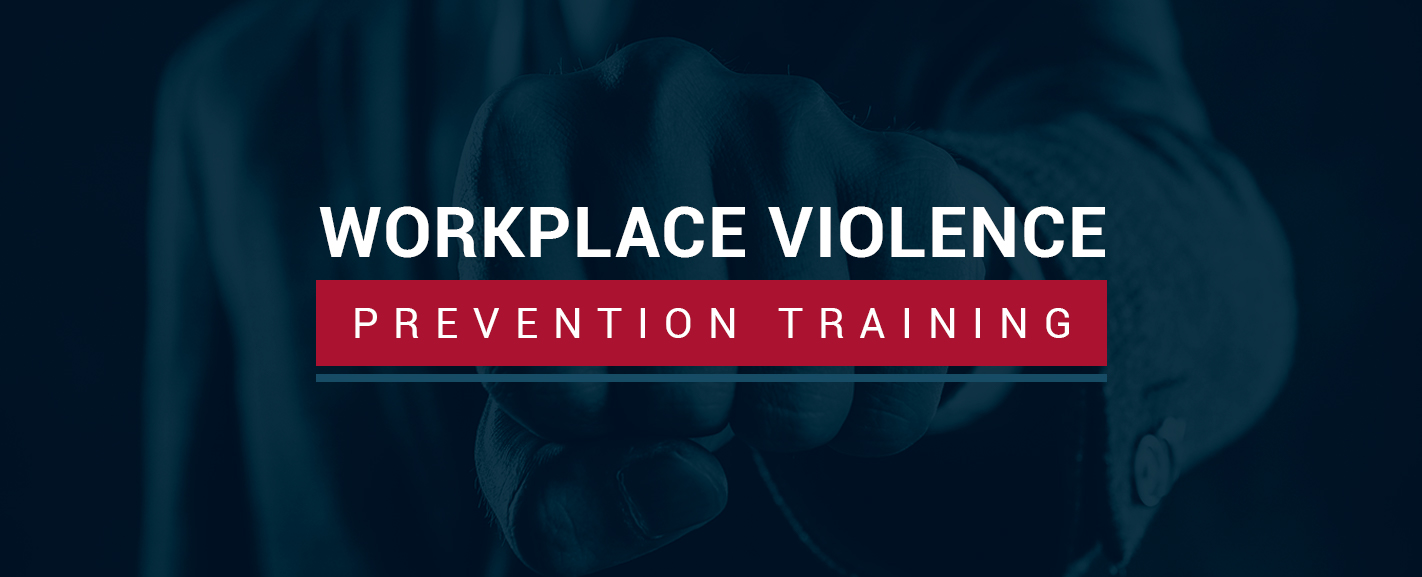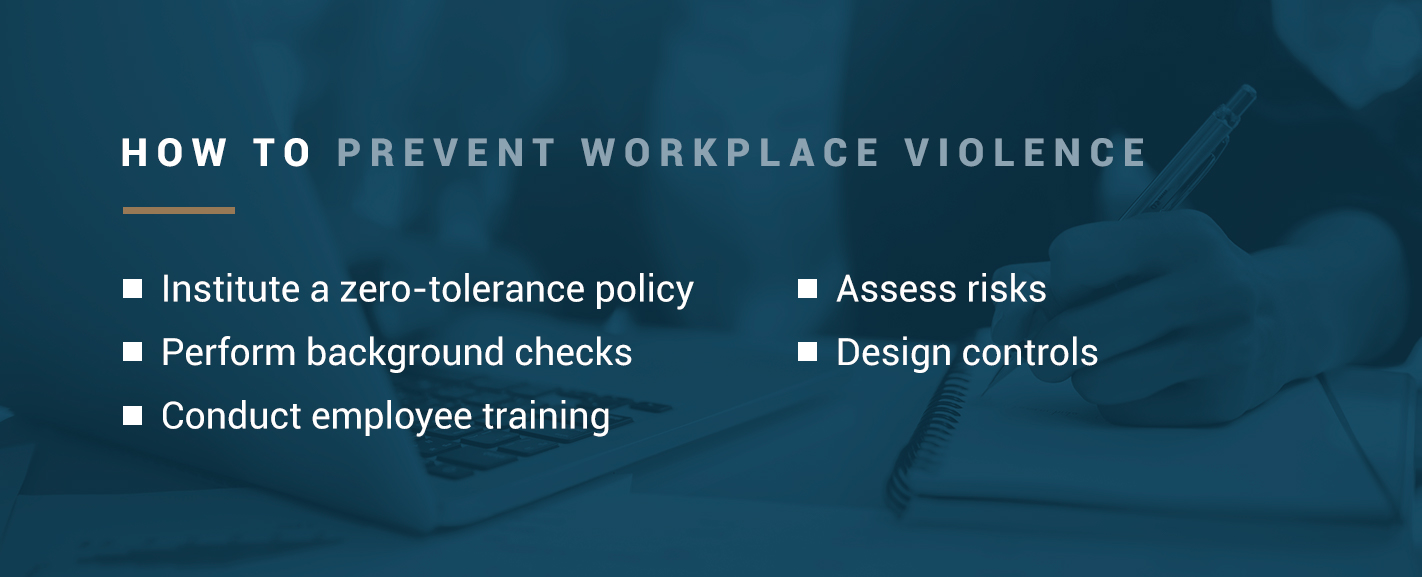Workplace Violence Prevention Training

Jump To:
- What Is Workplace Violence Prevention Training?
- Who Is at Risk of Workplace Violence?
- How to Prevent Workplace Violence
- OSHA Standards for Workplace Violence
- Workplace Violence Prevention Training Course Details
- Workplace Violence Prevention Specialist Certificate
- Sign up for Our Workplace Violence Prevention Specialist Training
Managing workplace violence is increasingly essential, since assaults at work are on the rise. In 2011, the U.S. saw 11,690 non-fatal incidents, and by 2018, the annual injuries had almost doubled, totaling 20,790. Employees and customers, violent patients and crime can all contribute to violence in the workplace. Violence in the workplace can take on many forms, including verbal abuse, sexual assaults, physical altercations and even homicide. The most deadly incidents involve active shooters.
As the second-leading cause of work-related deaths, workplace violence is a severe hazard. Learning violence prevention techniques and creating a comprehensive prevention program can help your organization reduce these threats.
Online Workplace Violence Prevention Training
What Is Workplace Violence Prevention Training?
Prevention of violence in the workplace starts with training. The right safety training course will give you the critical skills you need to:
- Understand the threat of workplace violence.
- Identify types of abuse, risk factors and potentially violent employees.
- Comply with workplace violence requirements and guidelines, keep appropriate records and report incidents.
- Respond to various forms of workplace violence, both in the moment and after they occur.
- Develop and manage engineering controls and employee training to prevent workplace violence.
As a workplace safety officer or HR specialist, you must create a workplace free from hazards. While many incidents of violence seem random, knowing the warning signs can help you stop assaults. The goal of prevention training is to develop your awareness and create a violence prevention plan.
Training courses may be available in a variety of formats and lengths. Some may provide resources, while others employ proven techniques to help you learn. The best courses offer certificates to show you have the necessary skills to keep your workplace safe.
Who Is at Risk of Workplace Violence?
When you look closely at how workplace assaults occur, patterns begin to emerge. We already know a lot about which work environments pose the highest risk, which employees are most vulnerable and who’s most likely to become an assailant. For example, many acts of violence at work occur alongside robberies.
The health care industry is one of the most susceptible to workplace violence. Nearly half of emergency physicians say they have experienced a physical assault at work. Some of the other vulnerable industries include education, transportation and retail.
Many workplace risk factors can increase the likelihood of violence at work. Employees may be at higher risk of violence if they:
- Exchange money with the public — for example, as sales associates or bank tellers.
- Work with volatile, unstable people.
- Work alone, in a small group or an isolated area.
- Provide services or care.
- Work in an establishment that serves alcohol.
- Work late at night or in an area with a high crime rate.
- Work as delivery or taxi drivers, health care professionals, customer service reps, public service workers or law enforcement officers.
Workplace Violence Prevention Specialist Course
How to Prevent Workplace Violence
Safety personnel and HR managers can use many methods to prevent workplace violence.
- Institute a zero-tolerance policy: The perception that employers will not retaliate against violence can increase risks. Tell employees you will not tolerate any violence, and stick to it. The policy should include workers, customers, patients, visitors, contractors or anyone else who might come in contact with staff. Treat any threat of violence as though the person will carry it out.
- Assess risks: Specific conditions can leave workers more vulnerable. Rooting out these hazards can help you impose the necessary policies, procedures and controls to prevent injuries. Also, analyze reported incidents to see what you can do to avoid similar situations.
- Design controls: Controls can be physical or administrative measures to reduce the risk of a particular hazard. Some engineering controls might be to install better lighting or closed-circuit security cameras. Administrative controls can include policies designed to limit violence. For example, a hospital can institute a rule that violent patients must remain under the close watch of security personnel and never have the chance to be alone with an employee or patient.
- Perform background checks: Look into new employees’ criminal backgrounds to see any recent violent behaviors. Any criminal convictions can indicate a risk of violence.
- Conduct employee training: Institute an influential safety culture and involve employees in safety. Employees should learn how to recognize and report incidents or potential threats and have a thorough understanding of company policy. They should also receive hands-on practice for handling workplace violence or active shooter situations safely and effectively.
OSHA Standards for Workplace Violence
It’s crucial to note the Occupational Safety and Health Administration (OSHA) doesn’t have any specified standards regarding workplace violence. Still, workplace violence is a recognized hazard included in OSHA’s General Duty Clause.
There are some guidelines for OSHA workplace violence prevention programs in high-risk industries. While these aren’t a requirement, they can go a long way toward stopping violence at work. Both the guidelines for health care and social service workers and late-night retail establishments list five components to a comprehensive prevention program:
- Management commitment and worker participation
- Worksite analysis
- Hazards prevention and controls
- Safety and health training
- Record-keeping and program evaluation
While not intended as official policies, these five elements can be helpful for any EHS or HR professional in any industry looking to prevent workplace violence.
Workplace Violence Prevention Training Course Details
- Violence in America and the workplace
- Identifying and defining types of violence
- Risk factors that contribute to violence or assault
- Recognizing an employee with the potential for violence
- Managing and surviving violence, threats and other disruptive behavior
- Record-keeping and reporting requirements associated with workplace violence
- Control measures, employee training and other elements of a workplace violence prevention plan
Workplace Violence Prevention Specialist Certificate
Successful completion of the NASP Workplace Violence Prevention Specialist Course can earn you a specialist-level certificate. You must pass an online exam at the end of the course and earn at least an 80% score to receive the certificate.
NASP has earned accreditation from the International Association for Continuing Education and Training, and our course is worth 1.3 continuing education units. Our workplace violence prevention certificate can show employers and employees you have qualified to reduce workplace violence threats. As a reputable third party for certificates, NASP can provide independent verification of your skill set.
Sign up for Our Workplace Violence Prevention Specialist Training
Get certified as a violence prevention specialist with our comprehensive, accredited workplace violence training program. Prove your expertise and gain new skills to advance your career and make your workplace safer with a workplace violence prevention certificate. If you wish to provide this or other safety training for a group of ten (10) or more, click here for any of your site-specific training needs. Often, one course can meet multiple regulatory requirements.
Purchase Workplace Violence Prevention Specialist Course
Related Posts






